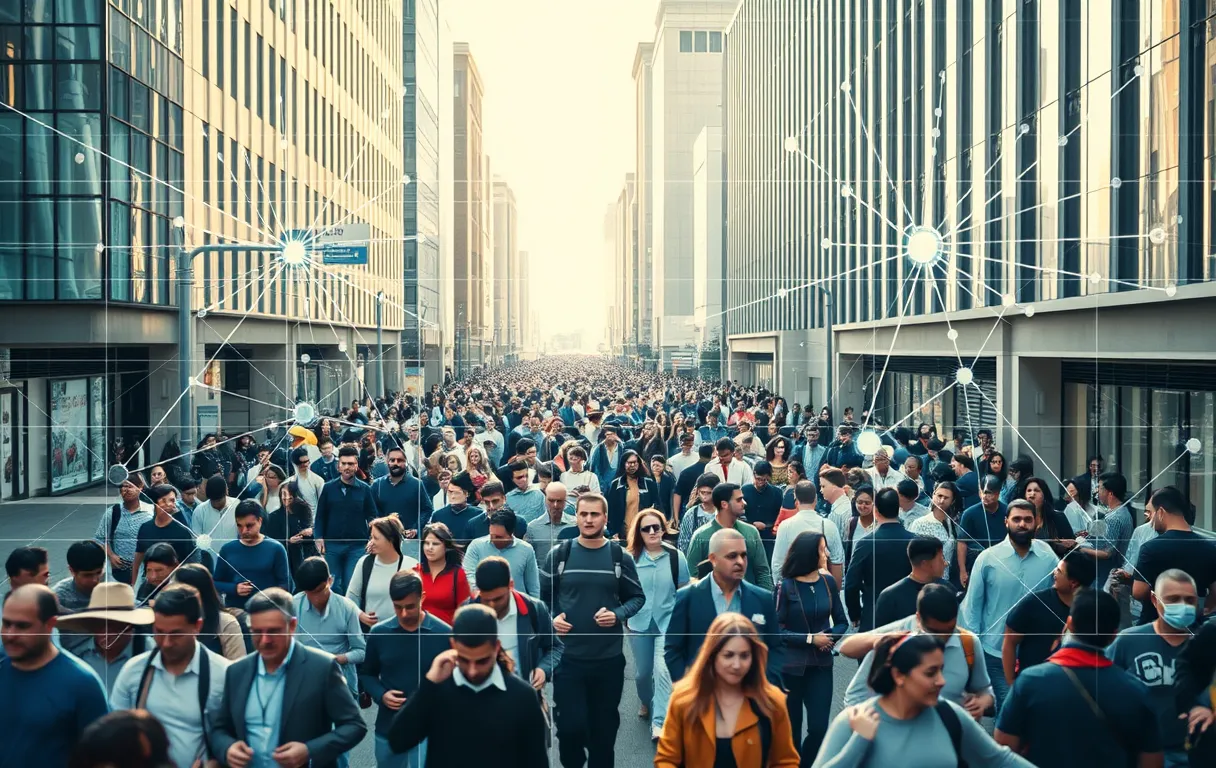
Understanding Occlusion in Crowd Analysis
What is occlusion in computer vision?
In crowd analysis, occlusion occurs when objects—often people—are partially or entirely hidden behind others. This is a common issue in densely packed gatherings where traditional camera systems fail to capture everyone in the frame clearly.
Common scenarios of occlusion
Occlusion frequently occurs at events like festivals, rallies, and sporting gatherings. These settings often feature overlapping individuals, which creates challenges for traditional camera-based monitoring systems.
Why occlusion is problematic
Occlusion severely affects the accuracy of crowd-monitoring technologies. Missed or misidentified individuals can result in incorrect headcounts or overlooked safety risks, compromising event management and security.
AI Techniques to Overcome Occlusion
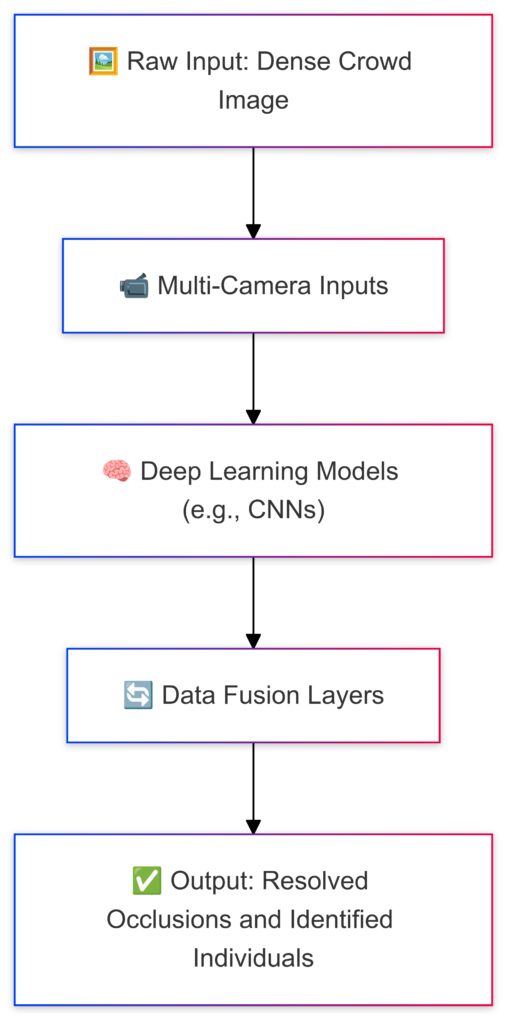
Step-by-step AI-driven workflow for resolving occlusion in crowded environments.
Deep learning models for person detection
Cutting-edge deep learning frameworks, such as YOLO (You Only Look Once) and Mask R-CNN, excel at detecting individuals even when they are partially hidden. These models predict visible body parts and reconstruct missing details with impressive accuracy.
Data fusion for better accuracy
Combining information from multiple sources, such as thermal imaging, drones, and depth sensors, allows AI systems to overcome blind spots. This fusion creates a composite view of the crowd, compensating for occlusion-related gaps.
3D modeling as a game-changer
3D mapping tools are transformative in resolving occlusion. By analyzing spatial relationships and layering depth data, they accurately locate obscured individuals and create a comprehensive representation of the crowd.
The Importance of Occlusion Detection
Enhancing safety in large-scale events
AI-driven occlusion detection systems play a critical role in identifying areas of overcrowding or congestion. This proactive approach allows event managers to address risks before they escalate.
Accurate headcounts matter
Precise crowd counting is essential for resource allocation, emergency planning, and logistical coordination. AI solutions help generate reliable data even in challenging scenarios.
Real-world challenges and solutions
For example, during the Hajj pilgrimage, advanced AI technologies addressed occlusion challenges, ensuring better crowd control and preventing potentially life-threatening stampedes.
Key Algorithms for Occlusion Resolution
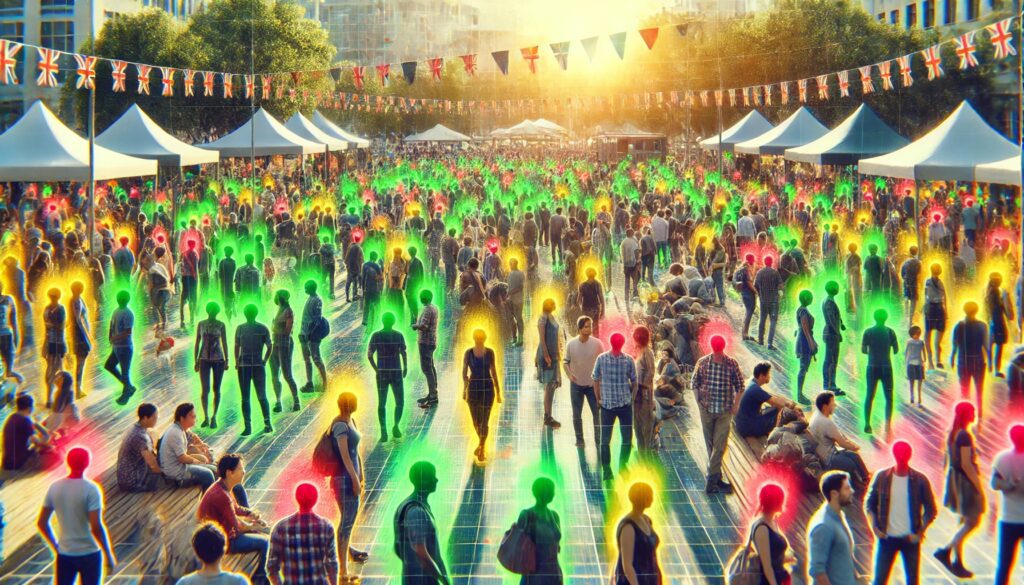
Convolutional Neural Networks (CNNs)
CNNs are instrumental in recognizing partially visible patterns in images. These networks excel in identifying obscured individuals by learning spatial and visual cues, making them ideal for occlusion tasks.
Generative Adversarial Networks (GANs)
GANs enhance occlusion resolution by reconstructing obscured portions of images. These networks generate realistic outputs that aid in monitoring dense gatherings more effectively.
Object tracking systems
Object tracking algorithms follow partially visible individuals across video frames. This ensures consistent monitoring of obscured persons, even in dynamic crowd scenarios.
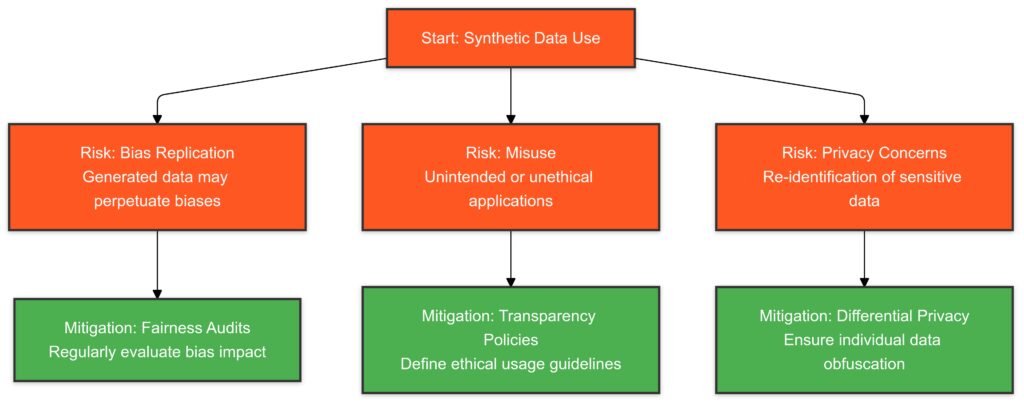
Applications Beyond Crowd Monitoring
Traffic and urban planning
AI techniques used in crowd occlusion analysis also have applications in urban environments. For example, they help in detecting traffic congestion and optimizing road usage.
Retail and customer insights
Retailers use similar AI-powered methods to monitor customer behavior in stores, even in areas with limited visibility. This data supports better product placement and store design.
Autonomous systems in dense environments
AI technologies capable of resolving occlusion assist autonomous vehicles and delivery robots in safely navigating through crowded areas, improving operational efficiency in urban settings.
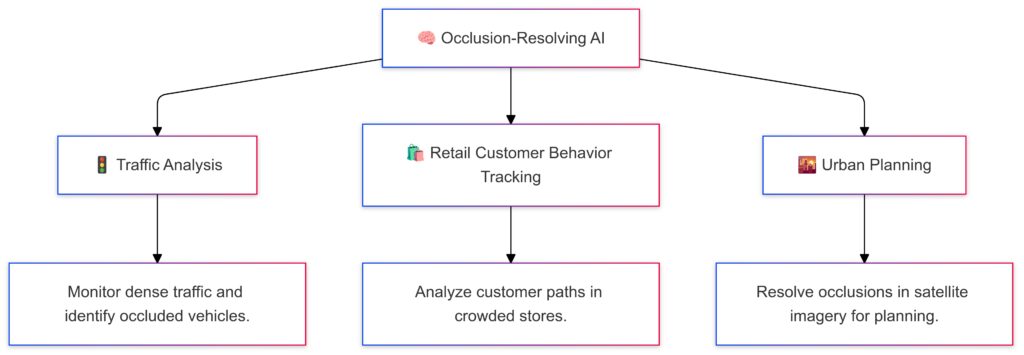
Challenges in Addressing Occlusion with AI
Data limitations in dense settings
AI models often rely on high-quality, annotated datasets to perform well. In occluded scenarios, obtaining sufficient labeled data is a significant challenge. Many datasets fail to capture the diversity of real-world crowd conditions, limiting model accuracy.
Computational demands of advanced algorithms
Advanced algorithms like GANs and 3D reconstruction models are computationally intensive. Processing high-resolution data from dense gatherings in real time requires powerful hardware, which may not always be feasible.
Real-world variability
Crowds are highly dynamic, with individuals constantly moving and interacting. Changes in lighting, weather, and crowd density add layers of complexity, making it harder for AI to maintain accuracy in occlusion-prone scenarios.
Emerging Technologies to Mitigate Occlusion
Multi-camera systems
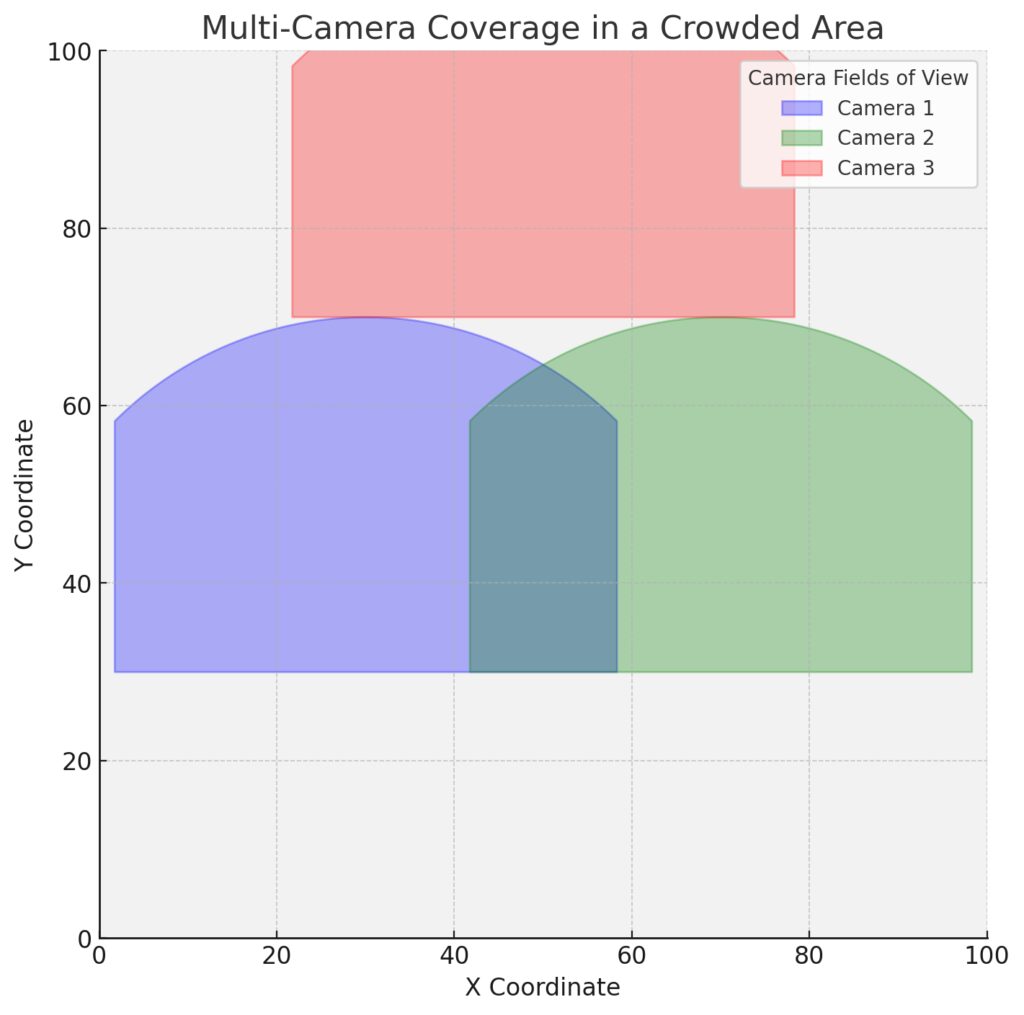
Camera Coverage: Each camera’s coverage is represented by a circular sector, showing the area monitored.
Overlapping Zones: The overlapping regions are visually blended due to the transparency of the fields.
Legend: Identifies individual cameras and their respective fields.
Deploying multi-camera arrays provides overlapping fields of view, reducing blind spots and minimizing the impact of occlusion. These systems are especially effective in large venues like stadiums.
LiDAR and depth-sensing technologies
LiDAR and depth sensors capture precise distance information, enabling AI to identify hidden individuals by reconstructing 3D environments. These tools are crucial in environments with extreme crowd density.
Synthetic data for training
To overcome the lack of real-world occlusion data, AI researchers use synthetic datasets. These datasets simulate diverse crowd scenarios, providing algorithms with extensive training material.
Ethical Considerations in Crowd Monitoring
Privacy concerns
AI-powered surveillance raises significant privacy issues, particularly in sensitive public gatherings. Striking a balance between safety and individual privacy is a critical ethical challenge.
Data misuse risks
The data collected for occlusion analysis can be misused for purposes unrelated to crowd safety, such as unauthorized surveillance or profiling. Transparent policies are essential to maintain public trust.
Bias in algorithms
AI systems trained on biased datasets may misidentify individuals based on factors like clothing, height, or skin tone. This highlights the need for diverse and inclusive training data to reduce discriminatory outcomes.
Future Prospects in Occlusion Analysis
AI-driven predictive modeling
Emerging technologies could predict crowd flow and occlusion patterns in advance, enabling authorities to act preemptively. Predictive modeling might revolutionize how large gatherings are managed.
Integration with IoT devices
Integrating AI-powered occlusion systems with IoT sensors—such as wearable devices or smart badges—offers real-time crowd monitoring and individual tracking, even in highly obstructed conditions.
Fully autonomous crowd management systems
Future AI systems could autonomously manage dense crowds by identifying risks, directing movement, and optimizing safety protocols without human intervention.
Industry Case Studies
Smart city implementations
Cities like Singapore and Barcelona have deployed AI systems to monitor and manage large public spaces. These initiatives highlight the potential of occlusion-resolving technologies in urban planning.
Entertainment and events
Organizers of large-scale events, such as the Olympics, are increasingly adopting AI solutions to manage attendee flow and address safety concerns related to crowd density.
Emergency response scenarios
AI-powered occlusion analysis has been instrumental in disaster management, aiding rescue teams in identifying trapped individuals within obscured areas.
Limitations of Current AI Approaches
Inability to handle extreme occlusion
Even the most advanced AI systems struggle in situations of severe occlusion, where individuals are almost entirely obscured. These limitations highlight the need for further innovation in algorithm design.
Dependence on ideal environmental conditions
Many AI models perform best in controlled environments. Real-world factors, such as poor lighting, weather interference, and camera positioning, continue to challenge the robustness of these technologies.
Cost and scalability challenges
Implementing high-tech systems, such as multi-camera arrays or LiDAR, can be prohibitively expensive. Scaling these solutions across large regions or multiple events remains a significant barrier.
Role of Collaborative Systems in Occlusion Analysis
Human-AI collaboration
Human experts can augment AI by validating system outputs and interpreting ambiguous results. This hybrid approach is particularly useful in high-stakes scenarios, such as crowd disaster management.
Integration with crowd behavior models
By combining occlusion-resolving AI with behavioral analysis models, systems can better predict and address crowd dynamics. This synergy enhances situational awareness and decision-making.
Cross-industry collaboration
Collaboration among technology providers, event organizers, and regulatory bodies ensures that occlusion-related technologies meet both practical needs and ethical standards.
Trends Driving Innovation in Occlusion Analysis
Federated learning for privacy-preserving AI
Federated learning allows AI models to improve by training on decentralized data sources, preserving individual privacy. This trend is particularly promising in surveillance-sensitive applications.
Edge computing for real-time processing
Shifting computation to edge devices reduces latency and enables real-time crowd monitoring, even in remote or bandwidth-limited environments.
Advancements in hardware
The development of more efficient GPUs and specialized chips, like Tensor Processing Units (TPUs), is making complex occlusion-resolving algorithms more accessible and scalable.
Global Impacts of Improved Occlusion Detection
Enhanced public safety
By accurately identifying hidden individuals and managing crowd dynamics, AI systems significantly reduce the risk of accidents and emergencies in large gatherings.
Economic benefits
Efficient crowd management reduces event costs by optimizing resource allocation. Additionally, improved safety protocols boost public confidence in attending large events.
Improved urban living
Beyond events, AI systems addressing occlusion contribute to smarter, more livable cities. They enhance mobility, reduce congestion, and improve the overall quality of life.
The Path Forward
Continuous research and development
Investments in AI research are crucial to overcoming the limitations of current occlusion-detection technologies. Future systems must be adaptable, cost-effective, and inclusive.
Education and training
Empowering event organizers and city planners with knowledge of AI systems ensures successful implementation and operation. Public awareness initiatives can also foster trust in these technologies.
Policy and regulation
Comprehensive policies must address ethical concerns, privacy issues, and data security in occlusion analysis. Governments and organizations must work together to create a framework that balances innovation with accountability.
Final Summary
AI-driven solutions for crowd occlusion are transforming the way dense and obscured gatherings are monitored. By leveraging technologies such as deep learning, multi-camera systems, and 3D modeling, these systems provide accurate and actionable insights that enhance public safety, urban planning, and event management. However, challenges such as data limitations, ethical concerns, and scalability issues remain critical areas for improvement. With continuous innovation and cross-sector collaboration, the future of occlusion analysis holds great promise for safer, smarter communities worldwide.
FAQs
How does AI handle partial occlusion in crowded environments?
AI overcomes partial occlusion using advanced techniques like Convolutional Neural Networks (CNNs) and 3D modeling. For instance, if a person’s lower body is obscured, systems like Mask R-CNN can reconstruct missing parts by analyzing visible body cues. Another example is during marathons, where AI models track runners despite frequent overlaps, ensuring accurate crowd monitoring.
Can occlusion-detection AI systems work in real time?
Yes, real-time occlusion detection is possible using edge computing and optimized hardware like GPUs or TPUs. Multi-camera setups and depth sensors further enhance real-time capabilities. For instance, at large concerts or stadiums, such systems can quickly identify congestion points and alert organizers to potential risks.
What industries benefit the most from AI occlusion solutions?
Several industries utilize occlusion-resolving AI:
- Event management: Large-scale events like the Olympics depend on AI to monitor crowd density and safety.
- Retail: Stores use AI to analyze customer behavior in crowded aisles, even if visibility is limited.
- Urban planning: Smart cities employ occlusion detection to optimize traffic flow and public space utilization.
- Emergency response: AI helps rescue teams locate individuals in obscured areas during disasters.
How does ethical AI address privacy concerns in crowd analysis?
Ethical AI systems anonymize data, only focusing on patterns rather than individuals. Federated learning ensures privacy by processing data locally instead of on central servers. For example, smart city projects in Europe comply with strict GDPR regulations, leveraging privacy-focused AI for crowd monitoring without compromising individual rights.
Are there affordable options for implementing occlusion-detection AI?
Yes, cost-effective solutions include cloud-based platforms and scalable AI software. Open-source tools like YOLOv5 provide robust functionality for smaller-scale projects. For example, local event organizers can use drone footage combined with free AI tools to monitor crowds effectively.
What role do drones play in overcoming occlusion challenges?
Drones provide an aerial perspective, reducing occlusion by capturing less obstructed views of crowds. Combined with AI, they create comprehensive maps of gatherings. For example, drones were used during the 2022 FIFA World Cup to monitor entry points and reduce bottlenecks.
How can occlusion detection improve safety at large events?
AI systems detect hidden crowd congestion points and predict movement patterns, helping prevent stampedes. For example, during the Hajj pilgrimage, AI-driven solutions identified overcrowding risks in real time, allowing authorities to reroute individuals and avoid accidents.
Does AI work equally well for all crowd densities?
AI performs well in medium to high-density crowds when combined with tools like multi-camera arrays or LiDAR. However, in extremely dense scenarios, where occlusion is near total, AI still faces limitations. For instance, in tightly packed subway stations, AI may need supplemental human oversight for the most accurate results.
How does AI differentiate between individuals in overlapping crowds?
AI uses object tracking algorithms and keypoint detection to differentiate between individuals. For instance, in a marathon where runners may overlap, AI can identify unique patterns like body movement, clothing colors, or facial landmarks. This enables systems to maintain individual tracking, even in dynamic and crowded settings.
What makes 3D modeling effective in resolving occlusion?
3D modeling reconstructs the spatial environment by analyzing depth and perspective. This allows AI to “see” hidden objects based on their estimated position in the 3D space. For example, in crowded amusement parks, 3D mapping helps security teams monitor visitors, even when obscured by tall rides or other attendees.
Are there limitations to multi-camera systems in occlusion detection?
While multi-camera setups reduce blind spots, they require careful synchronization to avoid data overlaps or gaps. Poor placement or calibration can lead to inconsistent monitoring. For instance, at a concert, cameras placed too high might miss people obscured by umbrellas or banners. Ensuring optimal angles and calibration is critical for success.
Can AI predict occlusion before it happens?
Yes, predictive analytics can anticipate occlusion by analyzing crowd density, movement patterns, and event layouts. For example, during parades, AI can predict congestion in areas where floats are stationed, allowing organizers to redirect attendees proactively.
How do occlusion-resolving technologies handle diverse lighting conditions?
AI uses adaptive algorithms that adjust for variations in brightness, shadows, or low-light environments. Infrared cameras and thermal imaging complement these systems, enabling crowd analysis in nighttime events or dimly lit spaces like clubs.
Is AI effective in detecting children or shorter individuals in crowds?
Yes, AI trained on diverse datasets can identify individuals of various heights, including children. Depth sensors and pose estimation algorithms are particularly helpful in such cases. For instance, during crowded theme park visits, AI can help locate lost children, even if they are partially hidden by adults.
How does AI deal with occlusion in disaster situations?
AI systems equipped with drones and LiDAR are instrumental during disasters. For example, after earthquakes, these technologies help identify survivors obscured by rubble or debris. AI systems process occluded visual data, enabling rescue teams to focus on critical areas.
What are some real-world examples of AI solving occlusion problems?
- Tokyo 2020 Olympics: AI systems ensured smooth crowd flow in venues by resolving occlusion issues in densely packed entryways.
- Singapore’s Changi Airport: AI-powered cameras monitor passenger movement, identifying hidden individuals in crowded security lines.
- Hajj pilgrimage: AI models have significantly reduced stampedes by addressing occlusion in dense crowds, predicting high-risk zones.
Can occlusion-resolving AI work with wearable technology?
Yes, wearable devices like smart badges or wristbands integrated with AI systems can enhance crowd monitoring. For example, RFID-enabled wristbands combined with occlusion detection help track attendee movements at large expos or conventions, even when people are obstructed from camera views.
What role does AI play in post-event analysis for occluded gatherings?
AI systems analyze post-event footage to reconstruct and evaluate crowd behaviors, even accounting for occlusion. This helps organizers understand movement patterns and improve layouts for future events. For instance, AI-assisted reviews of Black Friday store footage help optimize layouts to reduce bottlenecks and improve safety.
Resources
Academic Papers and Journals
- “Multi-Camera Network Calibration for Crowd Analysis”
Discusses methods for synchronizing multi-camera systems to overcome occlusion in dense environments.
Source: IEEE Transactions on Pattern Analysis and Machine Intelligence
Link - “Deep Learning for Occlusion Resolution in Dense Crowds”
Explores how convolutional networks address occlusion challenges in crowded scenes.
Source: Springer – Machine Vision Applications
Link - “3D Reconstruction Techniques for Large-Scale Crowd Monitoring”
A detailed analysis of how depth mapping and 3D modeling help in occlusion resolution.
Source: Elsevier – Computer Vision and Image Understanding
Tools and Technologies
- YOLO (You Only Look Once)
A popular open-source object detection tool that can handle partial occlusion effectively.
GitHub Repository: Link - Mask R-CNN
Advanced framework for instance segmentation and occlusion handling in image data.
GitHub Repository: Link - OpenCV
A comprehensive library for computer vision, including occlusion detection and image processing features.
Website: Link
Online Courses
- Deep Learning Specialization by Andrew Ng
Offered by Coursera, this course covers the foundations of deep learning models used in crowd analysis.
Website: Link - Computer Vision Fundamentals with OpenCV and Python
A practical course on using OpenCV for solving real-world occlusion and image analysis challenges.
Platform: Udemy
Link - AI for Smart Cities and Crowd Monitoring
Learn about AI applications for urban planning, including occlusion resolution techniques.
Platform: edX
Link
Industry Case Studies
- Singapore Smart Nation Initiative
Focuses on how AI resolves occlusion in monitoring public spaces and transport systems.
Official Website - Tokyo 2020 Olympics AI Systems
Demonstrates the use of AI and multi-camera systems for real-time crowd safety.
Details from NEC Corporation - Hajj Pilgrimage Crowd Management
Uses AI-powered occlusion detection to manage millions of pilgrims annually.
Case Study via Saudi Vision 2030
Books and Publications
- “Deep Learning for Computer Vision with Python” by Adrian Rosebrock
Offers hands-on examples for solving occlusion problems using computer vision. - “Computer Vision: Algorithms and Applications” by Richard Szeliski
A comprehensive guide covering 3D reconstruction and occlusion resolution techniques. - “Artificial Intelligence: A Guide to Intelligent Systems” by Michael Negnevitsky
An introductory book discussing AI applications in real-world scenarios like crowd analysis.
Link
Online Communities
AI Stack Exchange
A Q&A site for specific questions on AI technologies, including occlusion-related queries.
Link
Reddit: r/MachineLearning
Engage with practitioners discussing topics like occlusion detection and crowd analysis.
Link
Kaggle
A platform offering datasets and discussions related to occlusion challenges in AI projects.
Link